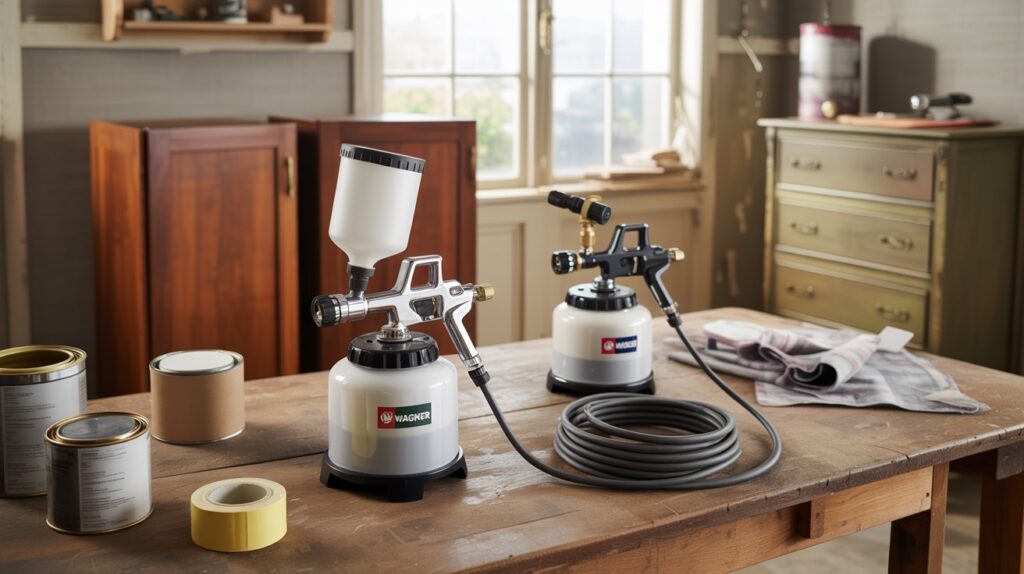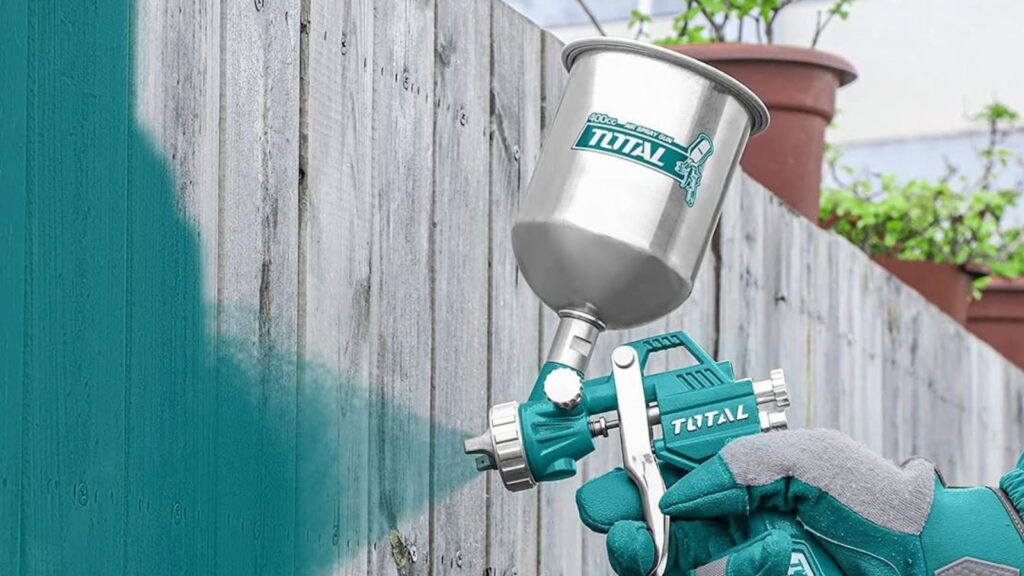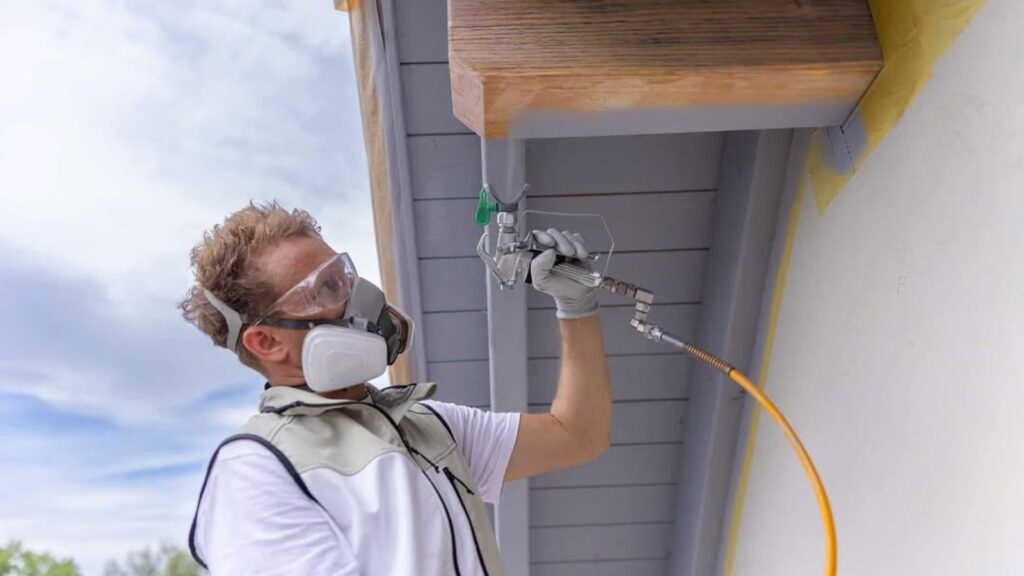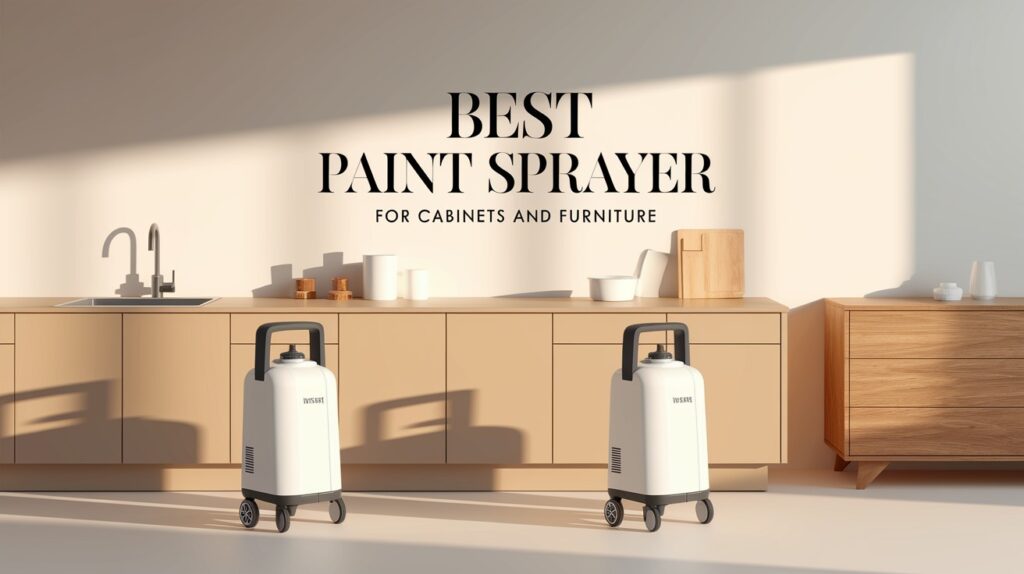I’ve been there. Standing in my workshop, staring at brush marks across my freshly painted cabinet doors. The finish looked bumpy. Uneven. Nothing like the smooth, professional results I wanted.
Traditional brushes and rollers can drive you crazy. They leave streaks. They waste time. They make detailed work nearly impossible.
That’s when I switched to paint sprayers. The difference was immediate. Smooth, even coats. Faster coverage. Professional results every time.
But here’s the thing – not all sprayers work the same. Some excel at furniture. Others handle large cabinet projects better. The wrong choice leaves you frustrated and disappointed.
This guide will help you pick the perfect sprayer for your specific needs. No guesswork. No buyer’s remorse. Just the right tool for beautiful results.
Why Use a Paint Sprayer for Cabinets and Furniture?

Traditional brushes and rollers struggle with detailed surfaces. They leave visible marks and create uneven texture. Paint sprayers eliminate these problems.
Sprayers deliver professional-quality finishes that look factory-made. They save massive amounts of time, coating cabinet doors in seconds instead of minutes. Complex surfaces with grooves and curves get even coverage without missed spots.
Perfect applications include kitchen cabinets, bathroom vanities, furniture pieces, and trim work. The investment pays off immediately with better results and faster completion.
Types of Paint Sprayers Explained

HVLP (High Volume, Low Pressure)
HVLP sprayers use high air volume at low pressure for exceptional control. They create minimal overspray, making them perfect for indoor use. Most come as handheld models or turbine systems.
These units excel at detailed furniture work where precision matters. The controlled spray pattern prevents paint waste and allows working in confined spaces like garages or basements.
Airless Sprayers
Airless sprayers pump paint at extremely high pressure without compressed air. This creates fast coverage and handles thick materials without thinning. They work best for large surface areas.
The high pressure means you can spray paint straight from the can. This saves time and maintains paint properties. However, the speed comes with increased overspray and less precision control.
Compressed Air Sprayers
Traditional spray guns use compressed air to atomize paint. They require a separate air compressor but offer superior finish quality. The air-to-paint ratio adjusts precisely for different applications.
Professional shops prefer these for high-end work, but the complexity makes them less practical for most home users. Setup requires matching the compressor capacity to gun requirements.
Paint Sprayer Pros and Cons
|
Sprayer Type |
Pros |
Cons |
|
HVLP |
• Superior finish quality • Minimal overspray and waste • Great for detailed work • Safe for indoor use • Easy to learn • Perfect for furniture |
• Slower coverage • May require paint thinning • Not for thick coatings • Limited power • Time-consuming for large jobs |
|
Airless |
• Very fast coverage • Handles thick paint • No air compressor needed • Great for large projects • Works with most paints • Consistent pressure |
• Significant overspray • Less finish control • Messy for indoor use • Higher paint consumption • Difficult cleanup • Requires extensive masking |
|
Compressed Air |
• Ultra-smooth finish • Precise control • Handles any paint type • Professional results • Adjustable pressures |
• Needs air compressor • High paint consumption • Major overspray • Complex setup • Higher costs • Steep learning curve |
Recommended Paint Sprayers for Cabinets and Furniture

Wagner Flexio 590 – Best for Beginners
This HVLP sprayer makes learning easy with simple controls. Two spray settings handle most projects without complexity. The 1.5-quart cup and 11.5-foot hose work well for furniture and small cabinet jobs.
Minimal overspray makes it garage-friendly. Quick cleanup reduces maintenance time. Perfect for first-time users wanting professional results.
Graco TrueCoat 360 – Pro-Level Results
This airless sprayer delivers professional finishes with impressive speed. 360-degree capability works at any angle. No paint thinning saves time. The 32-ounce capacity handles medium projects.
Reversible tips clear clogs instantly. Best for experienced users wanting airless speed with good control.
HomeRight Super Finish Max – Budget-Friendly Favorite
This HVLP unit offers excellent value without sacrificing quality. Three spray patterns handle different applications. The 27-ounce cup works for most furniture projects.
The brass tip provides durability. Lightweight design reduces fatigue. Perfect for budget-conscious occasional users.
Titan ControlMax 1700 Pro – Heavy-Duty Choice
This airless sprayer tackles large projects with power. The 0.60 HP motor maintains consistent pressure. High-efficiency technology reduces overspray.
The 25-foot hose provides excellent mobility. Handles thick materials without thinning. Best for large cabinet projects and frequent use.
Wagner Control Pro 130 – Balanced Performance
This high-efficiency airless balances speed with control. Reduced overspray technology makes it user-friendly. Stationary design provides stability.
The 25-foot hose reaches most areas. No thinning requirement. Ideal for medium to large projects with less mess than traditional airless.
Key Factors to Consider Before Buying
Project Size & Type: Match your sprayer to your typical projects. Furniture pieces need precision tools. Large cabinet jobs benefit from speed-focused units.
Ease of Use: Heavy units cause fatigue and poor results. Look for comfortable grips and simple controls. Balanced designs work better during long sessions.
Cleanup Process: Quick-clean systems save hours. Some flush with water in minutes. Others need complete disassembly. This determines how often you’ll use it.
Control Features: Different surfaces need different approaches. Adjustable pressure and patterns handle various materials and shapes effectively.
Portability: Handheld units offer maximum flexibility. Hose-based systems provide more power but limit movement. Consider your workspace needs.
Paint Compatibility: Check what paint types your sprayer handles. Latex can clog fine tips. Oil-based needs solvent cleanup. Compatibility matters for your preferred materials.
Top Features to Look For
Variable Settings: Fan width control adjusts pattern size. Flow control manages paint volume. Pressure adjustment matches different materials.
Interchangeable Tips: Different tips create different results. Fine tips for smooth finishes. Wide tips for fast coverage. Detailed tips for tight spaces.
Built-in Filters: Filters prevent clogs and ensure smooth operation. Look for easy access and washable materials.
Adequate Hose Length: Match the hose length to your typical working area. Quality hoses resist kinks and last longer.
Warranty and Support: Longer warranties show confidence. Check parts availability and customer service reviews.
Bonus: Pro Tips for First-Time Users
- Practice on scrap wood first to test patterns and get comfortable.
- Always strain paint to remove lumps that cause clogs.
- Keep the sprayer 6-8 inches away and move at a steady speed.
- Clean within 30 minutes to prevent paint hardening.
- Thin paint when the manufacturer’s guidelines require it.
- Overlap spray passes by 50% for complete coverage.
- Work in clean areas with good ventilation.
- Start spraying before reaching the workpiece, and continue past the edge.
- Apply multiple thin coats instead of one thick coat.
Conclusion
Choosing the right paint sprayer your cabinet and furniture projects completely. The difference between struggling with brushes and achieving professional results comes down to matching the tool to your specific needs.
Consider your project size first. Small furniture pieces work best with HVLP sprayers. Large cabinet projects may benefit from airless power. Factor in your skill level, too. Beginners should start with user-friendly models.
Don’t forget about cleanup and maintenance. The best sprayer is worthless if it’s too difficult to clean and maintain properly.
Your investment will pay off immediately. Professional-quality finishes. Faster project completion. Better results every time.
I’d love to hear about your projects. What type of sprayer are you considering? Have questions about specific models? Share your thoughts in the comments below. Your experience might help other readers make better choices.
Frequently Asked Questions
Can I use a paint sprayer indoors?
Yes, but choose the right type. HVLP sprayers work best indoors because they create minimal overspray. Always ensure good ventilation and protect surrounding surfaces. Avoid airless sprayers indoors unless you can mask extensively.
What’s the best paint to use in a sprayer for cabinets?
High-quality acrylic paint works best for cabinets. Look for paint labeled “spray-friendly” or “self-leveling.” Avoid cheap paint that may clog your sprayer. Primer is essential for proper adhesion and durability.
Do I need to sand before spraying furniture?
Yes, always sand or at least scuff the surface. This helps paint stick properly. Use 220-grit sandpaper for most surfaces. Clean thoroughly after sanding to remove all dust particles.
Is it better to rent or buy a paint sprayer?
Buy if you plan multiple projects or want to maintain the tool properly. Rent for one-time large projects where you need expensive equipment. Consider that rental units may not be well-maintained.
How do I avoid drips and overspray?
Keep a consistent distance and speed. Don’t hold the trigger in one spot. Use proper masking and ventilation. Practice your technique on scrap material first. Start with thin coats rather than trying to cover in one pass.

